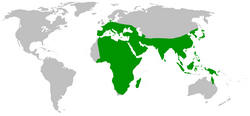Description
Dugesia species have an elongated body with a slightly triangle-shaped head. They often have grey, brown, or black dorsal color, whereas the ventral surface is usually paler. These animals have a couple of eyes constituted by a multicellular pigmented cup with many retinal cells to detect the amount of light in the nearby environment. Sometimes they present supernumerary eyes. At the anterior part of the body, behind the eye level, they have a pair of structures called auricles that give the triangle look to the 'head' and allow them to detect the intensity of water current. These auricles are free of pigment and rhabdites. Each side of the anterior margin of the head has between 5 and 10 shallow sensory fossae, their number depending on the species or the individual. The sensory fossae and the auricle grooves are supplied with many nerve endings. [3]
The digestive system of Dugesia contains a central, non-pigmented tubular pharynx. Like the other triclads, the gut consists of three branches, one anterior and two posterior. Each branch consists of caeca, which deliver the nutrients to the body. The gut lacks a separate opening for waste excretion. [4]
The subepidermal musculature of Dugesia is divided into four layers. [3]
In Dugesia the ovaries are ventrally situated, they start just behind the brain, usually at the level of the fourth intestinal branch. The bursal canal runs on the right side of the copulatory apparatus and above the atrium. [3] Like some Neppia species, species of Dugesia have a third layer of longitudinal musculature over the vaginal area of the bursal canal. This feature is not present in other triclads. Another feature shared with Neppia is the presence of a glandular area at the transitional area between the seminal vesicle and the ejaculatory duct, although in Dugesia these glands are concentrated at the diaphragm, a structure not present in any other genera. [5] Ball proposed that the presence of this glands was a synapomorphy of Dugesia and Neppia. The absence of these glands in some Neppia species (N. jeanneli, N. montana and N. schubarti) is thought to be a secondary loss. [6]
This page is based on this
Wikipedia article Text is available under the
CC BY-SA 4.0 license; additional terms may apply.
Images, videos and audio are available under their respective licenses.



